Emily Roebling's husband was the chief engineer of the Brooklyn Bridge, but when he fell ill soon after construction began, Emily spent over a decade working as his liaison, supervising the site, and ensuring that the structure was built to his specifications.
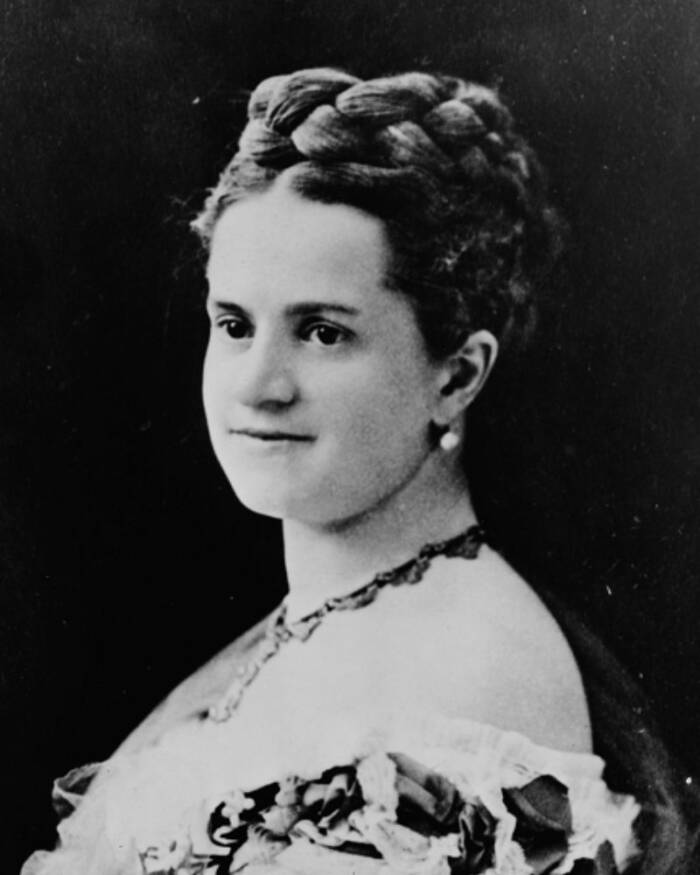
Library of CongressEmily Roebling between 1860 and 1880, perhaps during the construction of the Brooklyn Bridge.
Emily Roebling was the first person to cross the Brooklyn Bridge after its completion in 1883. This wasn’t by chance, however.
Her husband, Washington Roebling, was the chief engineer during the construction of the bridge, but he fell ill from decompression sickness just a couple of years into the project. So, despite having no formal training as an engineer, Emily took the reins.
For over a decade, Emily Roebling acted as a liaison between her husband and the construction site, passing instructions to workers, asking questions, supervising the project, and attending board meetings. She even learned a thing or two about engineering, from stress analysis to the importance of cable placement.
And when the Brooklyn Bridge officially opened in 1883, Emily was lauded as the driving force behind its completion, forever tying her to the legacy of the iconic New York City landmark.
Emily Warren Roebling’s Early Years And Marriage
Emily Warren Roebling was born about an hour north of New York City in 1843. Her family was fairly wealthy, and she was well-educated, particularly for a young girl at the time.
When the Civil War broke out, Emily’s brother Gouverneur Warren raised a local regiment for the Union Army and rose through the ranks to become a major general. In 1864, Emily visited Gouverneur and attended a ball held for the soldiers. There, she met Washington Roebling, and she married him the following year.
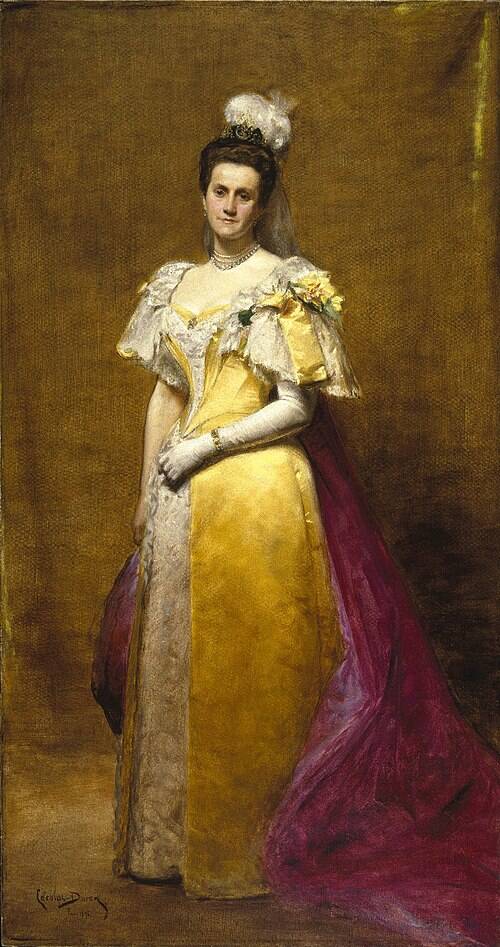
Public DomainA portrait of Emily Warren Roebling, circa 1896.
In 1867, Washington’s father, John A. Roebling, started designing what would become the Brooklyn Bridge. That year, Washington and Emily Roebling traveled to Europe to learn more about caissons — watertight chambers built in lakes, rivers, oceans, or other bodies of water to allow for the construction of underwater structures like bridge piles and foundations.
Soon after their return, John fell ill with tetanus after his foot was crushed by a ferry while he was visiting the future site of the Brooklyn Bridge. He died in July 1869, but his son immediately picked up where he’d left off and was soon named the chief engineer.
Washington Roebling didn’t fare much better than his father had, however. Around 1870, he developed decompression sickness from diving into the East River to inspect the bridge’s caissons. He became bedridden — but Emily Roebling wasn’t going to let this setback destroy her husband’s dreams.
The Construction Of The Brooklyn Bridge
Despite not having any formal engineering training, Emily stepped up to help Washington complete the Brooklyn Bridge. She taught herself everything she could about bridge construction, and she visited the project site almost every day to supervise and pass on information from Washington.
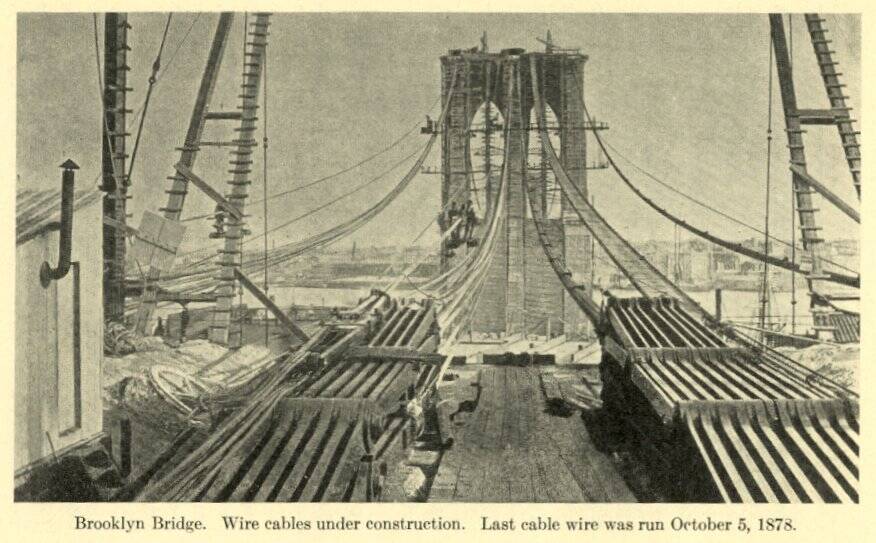
Public DomainThe completion of the Brooklyn Bridge project fell to Emily Roebling after her husband became bedridden from decompression sickness.
She took meticulous notes, shared her findings with her husband, asked him any questions the on-site engineers had, and carried additional instructions to the bridge each day. In fact, Emily Roebling was so knowledgeable about the project that some people even assumed she was the new chief engineer.
Emily also advocated for her husband so he wouldn’t be replaced. She attended board meetings in his stead and met with politicians and other officials to ensure that Washington could maintain his position.
Finally, in 1883, the Brooklyn Bridge was completed. The official opening ceremony was held on May 24, and Emily Roebling was the first person to cross the bridge, with her carriage traveling just ahead of President Chester Arthur’s.
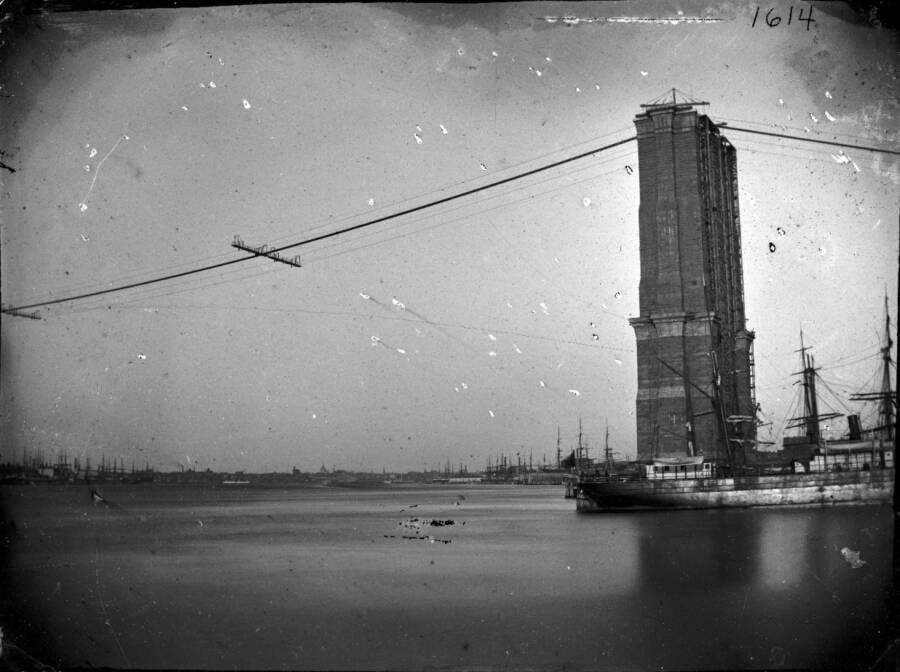
Brooklyn Museum/Wikimedia CommonsEmily Roebling learned the basics of civil engineering to help finish the Brooklyn Bridge.
At the ceremony, Abram Stevens Hewitt — a politician and industrialist who would later go on to become the mayor of New York City — honored Emily in his speech. Hewitt called the Brooklyn Bridge “an everlasting monument to the self-sacrificing devotion of woman, and of her capacity for that higher education from which she has been too long debarred.”
Hewitt continued, “The name of Mrs. Emily Warren Roebling will thus be inseparably associated with all that is admirable in human nature, and with all that is wonderful in the constructive world of art.”
Emily Roebling’s accomplishments didn’t end with the Brooklyn Bridge, though.
Emily Roebling’s Inspirational Later Life
Once the Brooklyn Bridge was completed, Washington and Emily Roebling settled in New Jersey. But Emily was far from done making waves.
She became involved in numerous women’s causes, joining groups like the Daughters of the American Revolution. She also had a role on the Board of Lady Managers for the 1893 Chicago World’s Fair.
Roebling returned to Europe, too, attending the coronation of Czar Nicholas II in 1894 and meeting Queen Victoria in 1896. And, determined to get a higher education, she earned a law certificate from New York University. She published an essay on women’s rights in the Albany Law Journal in 1899.
Sadly, her inspirational life came to an end on Feb. 28, 1903, when she died from stomach cancer at 59 years old. Despite Washington Roebling’s previous ill health, he lived on until 1927, remarrying five years after Emily’s death.
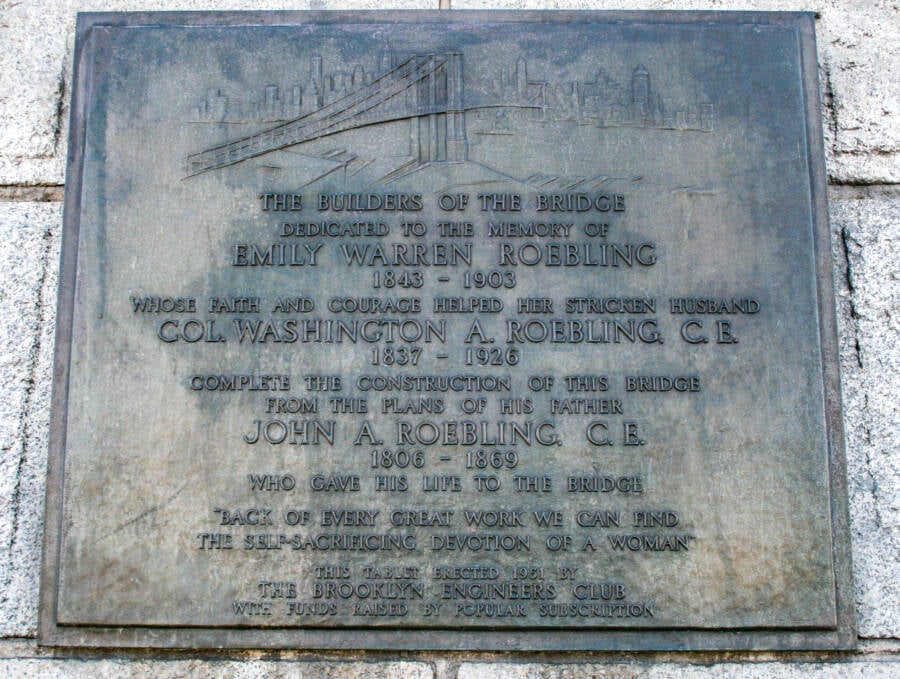
Szilas/Wikimedia CommonsA plaque on the Brooklyn Bridge honors the contributions of the Roebling family.
Still, Emily Roebling’s legacy as a female engineer and the force behind the Brooklyn Bridge will be remembered for generations to come. Most recently, her role in the bridge’s construction was featured in the HBO series The Gilded Age
Today, a plaque on the Brooklyn Bridge reads: “Dedicated to the memory of Emily Warren Roebling… whose faith and courage helped her stricken husband Col. Washington A. Roebling… complete the construction of this bridge from the plans of his father John A. Roebling… who gave his life to the bridge. Back of every great work we can find ‘the self-sacrificing devotion of a woman.'”
After reading about Emily Roebling’s crucial role in the construction of the Brooklyn Bridge, look through these 21 stunning photos of the Golden Gate Bridge. Then, learn about a different era of Brooklyn’s history through these photos from the 1960s.





